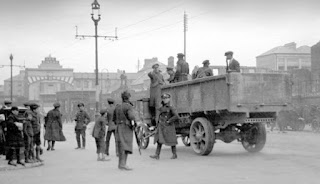Just after 6pm on the evening of November 17th 1920 Sergeant James O'Donoghue left his home on Tower Street and proceeded to walk to his barracks on Tuckey Street.
As he walked down White Street three men hiding in the gateway of Desmond's Builders Yard emerged with pistols drawn. Shots rang out and Sergeant O'Donoghue fell dead with two bullets in his back and one in his head.
Today - White Street, off Douglas Street.
Sergeant O'Donoghue was 46 years old and married with four children. Originally from Cahirsiveen Co. Kerry, he had 22 years service in the RIC.
Tuckey Street RIC Barracks, across from the Freemasons Hall, today it is the Society of St Vincent de Paul.
Sergeant O'Donoghue was not initially a target of the Cork IRA, in fact he had been well liked in the locality and was known to rebuke Tans in his barracks who acted like thugs. When news of his killing spread across the city many people thought it was the Tans who killed him.
O'Donoghue's killing was carried out by IRA Volunteers Charlie O'Brien and brothers William and Justin O'Connor. Senior officers in the First Cork Brigade were furious with them. It was not sanctioned and they sent a letter of apology to O'Donoghue's widow.
Sergeant O'Donoghue was buried in his native Cahirsiveen. His heartbroken wife never recovered from the shock of his killing, she died three years later.
The killing of O'Donoghue later sparked off a reprisal when a number of RIC and Tans terrorised the tenements of Broad Lane where a number of IRA members lived. They killed and maimed in the name of their dead colleague but, it was a reprisal O'Donoghue certainly would not have wanted and his was a killing that should not have happened.



























































